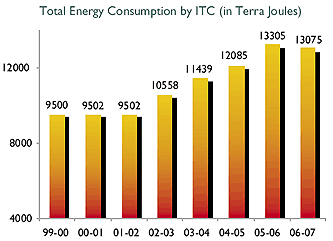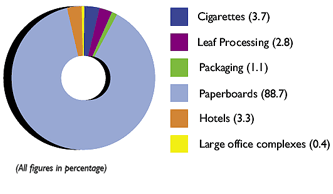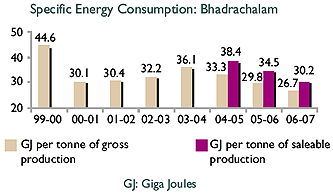

Our operations consumed 13,075 Terra Joules of energy in 2006-07, a reduction of 1.73% over the previous year. This is particularly remarkable because during the year, Paperboards & Specialty Papers’ production went up by 7.8%, Cigarettes grew by 10.9%, Leaf production went up by 10.6% and Packaging & Printing business grew 14.7%.


Our Paperboards & Specialty Papers business is the largest consumer (88.7%) of energy in the organisation.
Of the four units in this business, the Bhadrachalam unit alone accounts for 65.5% of total energy utilised by all our operations.
ITC witnessed a 1.73% reduction in total energy consumption
despite a significant growth in all our businesses. |
 The Bhadrachalam unit continued energy conservation efforts in 2006-07 to further reduce specific energy consumption by 12.5% on saleable production. The Bhadrachalam unit continued energy conservation efforts in 2006-07 to further reduce specific energy consumption by 12.5% on saleable production.
This is a remarkable achievement for a Paperboards unit that is not only the greenest paperboards mill in India but also amongst one of India’s most energy efficient ones. (All About Paper – The life cycle of the Indian pulp & paper Industry, Green Rating Project by The Centre for Science and Environment, 2004).
The Cigarettes business reduced specific energy consumption from 8.62 to 7.34 GJ per million cigarettes equivalent (a reduction of 14.8% over the previous year). The Cigarette factories at Munger and Saharanpur achieved 25.5% and 24.7% reduction in specific energy consumption, respectively.
This compares well with the British American Tobacco average specific energy consumption
of 18.17 GJ/million cigarettes equivalent. (British American Tobacco - Social Reporting: 2006 progress and review.)
The Leaf Tobacco unit in Chirala is well known in the International Leaf fraternity to be amongst the most energy efficient units in the world. |
The production flow in Chirala is at differential levels to take advantage of gravity, thereby eliminating the need for a number of power-intensive pneumatic air lifts. Chirala, in 2006-07, reduced specific energy consumption from 4.61 to 3.91 GJ per tonne of leaf tobacco (Specific Energy reduction of 15.3% over the previous year). This coupled with a 21.7% reduction in Anaparti has brought the specific energy consumption in our Leaf business from
5.35 to 4.23 GJ/tonne of leaf (a reduction of 20.8% over the previous year).
|

